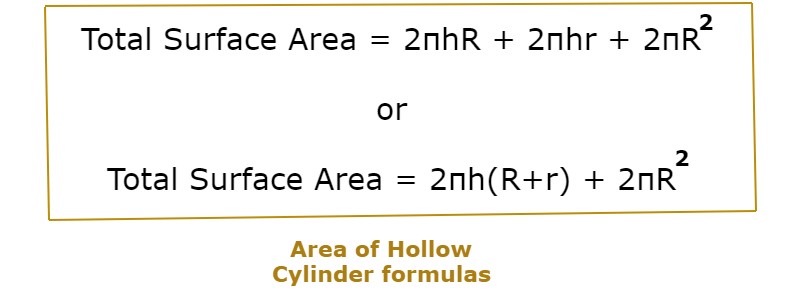What is a Hollow Cylinder?
A hollow cylinder is a 3d object that has two circular bases of different radius, and a curved lateral surface joining the bases. It is similar to a regular cylinder, but with a hollowed-out center.
The area of a hollow cylinder can be get by calculating the sum of the areas of its lateral surface and its two circular bases.
The lateral surface area of a hollow cylinder is the curved surface area that combines the two circular bases.
Area of Hollow Cylinder formulas
To calculate the lateral surface area, we need to find the circumference of both bases and then multiply it by the height of the cylinder.
Since the cylinder is hollow, we need to subtract the area of the inner base from the area of the outer base. Mathematically, we can express this as:
Lateral Surface Area = 2πh(R+r)
where h is the height of the cylinder, R is the radius of the outer base, and r is the radius of the inner base.
The total surface area of the hollow cylinder is the sum of its lateral surface area and the area of its two circular bases.
The area of a circle can be found using the formula A = πr2,
where A is the area of the circle and r is its radius. Therefore, the area of the two circular bases can be calculated as follows:
Area of outer base = πR2
Area of inner base = πr2
The total surface area of the hollow cylinder is therefore:
Total Surface Area = 2πh(R+r) + πR2 + πr2
So the formula, we get:
Examples of the Hollow Cylinder
Example 1: Find the area of a hollow cylinder with inner radius 3 cm, outer radius 5 cm, and height 8 cm.
Solution:
We can use the formula for the surface area of a hollow cylinder:
Total Surface Area = 2πh(R+r) + 2πR2
where h is the height, R is the outer radius, and r is the inner radius.
Total Surface Area = 2π(8)(5+3) + 2π(52) – 2π(32)
= 2π(8)(8) + 2π(25) – 2π(9)
= 128π + 50π – 18π
= 160π
Example 2: Find the surface area of a hollow cylinder with inner radius 2.5 cm, outer radius 6.5 cm, and height 12 cm.
Solution:
We can use the formula for the surface area of a hollow cylinder:
Total Surface Area = 2πh(R+r) + 2πR2
where h is the height, R is the outer radius, and r is the inner radius.
Total Surface Area = 2π(12)(6.5+2.5) + 2π(6.52) – 2π(2.52)
= 2π(12)(9) + 2π(42.25) – 2π(6.25)
= 216π + 84.5π – 15.5π
= 285π

